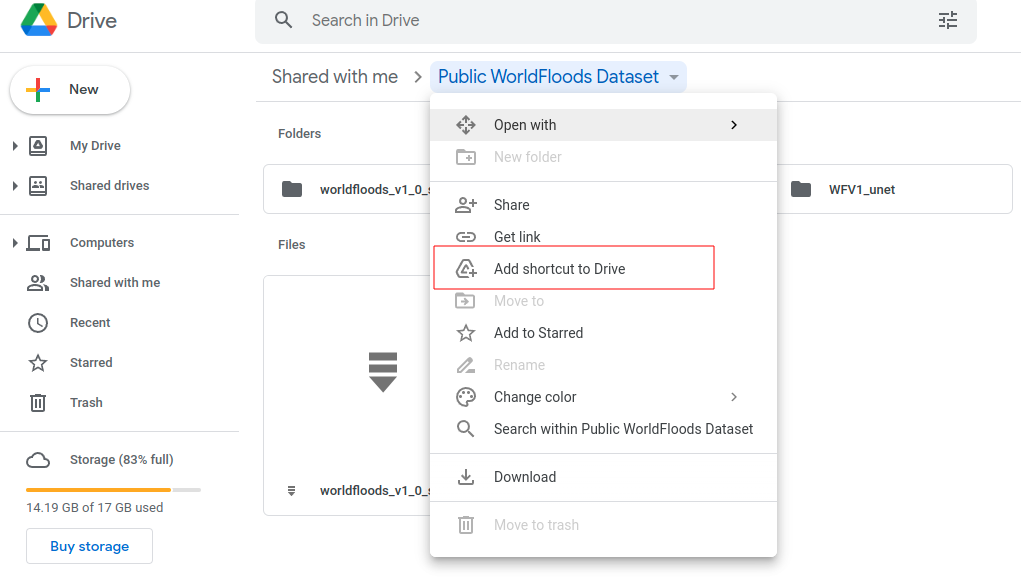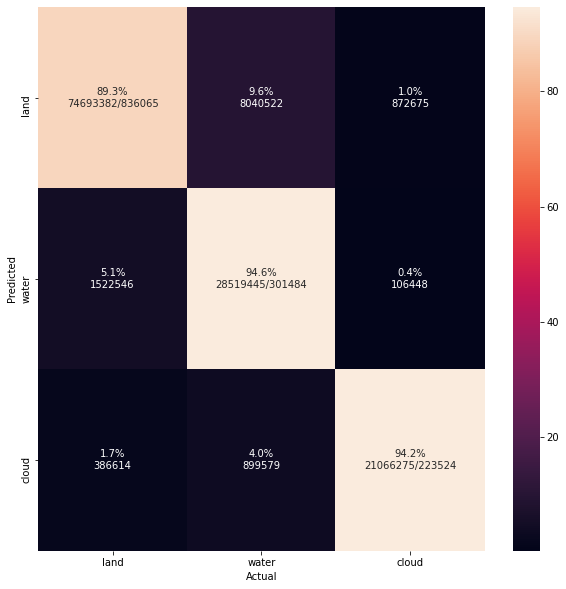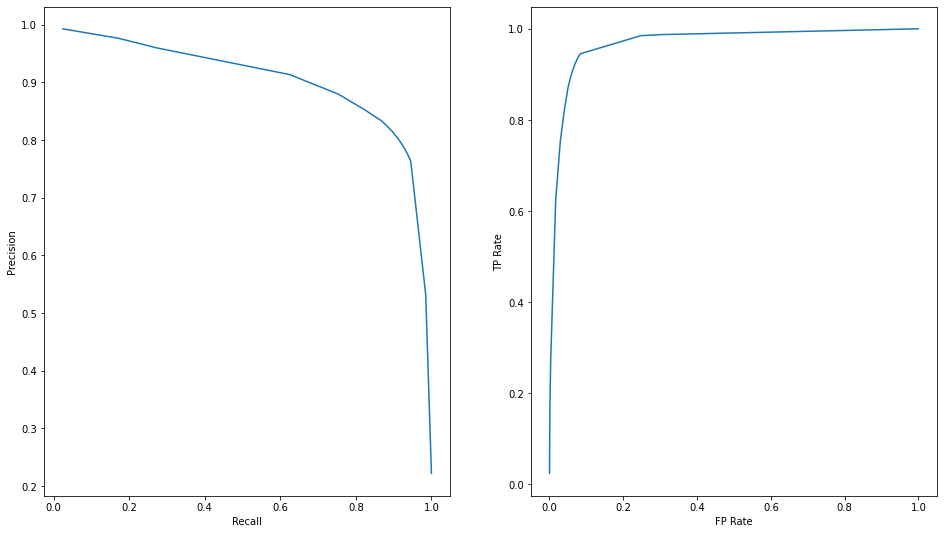Model Metrics
Contents
Model Metrics#
Last Modified: 18-03-2022
Authors: Sam Budd, Gonzalo Mateo-García
This notebook shows how to compute metrics for a trained model on the WorldFloods test dataset. The notebook is divided in 4 steps:
Load the config file of the experiment.
Create a dataloader for the test dataset.
Create the segmentation model and load their weights
Run inference on all images in the dataset and compute metrics
Note: If you run this notebook in Google Colab change the running environment to use a GPU.
import os
Step 0: Get the data#
For this tutorial we need the test dataset and the model trained on the WorldFloods dataset. For this tutorial we will get it from our public Google Drive folder. For other alternatives see the download WorldFloods documentation.
Step 0a: mount the Public folder if you are in Google Colab#
If you’re running this tutorial in Google Colab you need to ‘add a shortcut to your Google Drive’ from the public Google Drive folder.

Then, mount that directory with the following code:
try:
from google.colab import drive
drive.mount('/content/drive')
assert os.path.exists('/content/drive/My Drive/Public WorldFloods Dataset'), "Add a shortcut to the publice Google Drive folder: https://drive.google.com/drive/u/0/folders/1dqFYWetX614r49kuVE3CbZwVO6qHvRVH"
google_colab = True
path_to_dataset_folder = '/content/drive/My Drive/Public WorldFloods Dataset'
dataset_folder = os.path.join(path_to_dataset_folder, "worldfloods_v1_0_sample")
experiment_name = "WFV1_unet"
folder_name_model_weights = os.path.join(path_to_dataset_folder, experiment_name)
except ImportError as e:
print(e)
print("Setting google colab to false, it will need to install the gdown package!")
google_colab = False
Step 0b: If you are in a jupyter notebook, download the data with the gdown package#
Download the data using the gdown package (if not installed run: pip install gdown).
# Download pre-trained model from Google Drive folder
# Download pre-trained model from Google Drive folder
if not google_colab:
experiment_name = "WFV1_unet"
# Download val folder
path_to_dataset_folder = '.'
dataset_folder = os.path.join(path_to_dataset_folder, "worldfloods_v1_0_sample")
folder_name_model_weights = os.path.join(path_to_dataset_folder, experiment_name)
if not os.path.exists(folder_name_model_weights):
import gdown
gdown.download_folder(id="1Oup-qVD1U-re3lIQkw7TOKJsdu90blsk", quiet=False, use_cookies=False,
output=folder_name_model_weights)
# Download val folder
test_folder = os.path.join(dataset_folder, "test")
if not os.path.exists(test_folder):
import gdown
os.makedirs(test_folder, exist_ok=True)
# https://drive.google.com/drive/folders/1Bp1FXppikOpQrgth2lu5WjpYX7Lb2qOW?usp=sharing
gdown.download_folder(id="1Bp1FXppikOpQrgth2lu5WjpYX7Lb2qOW", quiet=False, use_cookies=False,
output=test_folder)
Step 1: Get config#
from ml4floods.models.config_setup import get_default_config
config_fp = os.path.join(folder_name_model_weights, "config.json")
# config_fp = f"gs://ml4cc_data_lake/2_PROD/2_Mart/2_MLModelMart/{experiment_name}/config.json"
config = get_default_config(config_fp)
config["model_params"]["max_tile_size"] = 1024
Loaded Config for experiment: WFV1_unet
{ 'data_params': { 'batch_size': 32,
'bucket_id': 'ml4floods',
'channel_configuration': 'all',
'filter_windows': False,
'input_folder': 'S2',
'loader_type': 'local',
'num_workers': 8,
'path_to_splits': '/worldfloods/public',
'target_folder': 'gt',
'test_transformation': { 'normalize': True,
'num_classes': 3,
'totensor': True},
'train_test_split_file': 'worldfloods/public/train_test_split.json',
'train_transformation': { 'normalize': True,
'num_classes': 3,
'totensor': True},
'window_size': [256, 256]},
'deploy': False,
'experiment_name': 'WFV1_unet',
'gpus': '0',
'model_params': { 'hyperparameters': { 'channel_configuration': 'all',
'label_names': [ 'land',
'water',
'cloud'],
'lr': 0.0001,
'lr_decay': 0.5,
'lr_patience': 2,
'max_epochs': 25,
'max_tile_size': 256,
'model_type': 'unet',
'num_channels': 13,
'num_classes': 3,
'val_every': 1,
'weight_per_class': [ 1.93445299,
36.60054169,
2.19400729]},
'model_folder': 'gs://ml4cc_data_lake/0_DEV/2_Mart/2_MLModelMart',
'path_to_weights': 'checkpoints/',
'test': False,
'train': True,
'use_pretrained_weights': False},
'resume_from_checkpoint': False,
'seed': 12,
'test': False,
'train': False,
'wandb_entity': 'ml4floods',
'wandb_project': 'worldfloods'}
Step 2: Load dataloader#
from ml4floods.models import dataset_setup
config.data_params.loader_type = 'local'
config.data_params.path_to_splits = dataset_folder # local folder to download the data
config.data_params.bucket_id = ""
config.data_params.train_test_split_file = None
if "filter_windows" in config["data_params"]:
del config["data_params"]["filter_windows"]
from ml4floods.data.worldfloods.dataset import WorldFloodsDatasetTiled, WorldFloodsDataset
from glob import glob
from ml4floods.models.model_setup import get_channel_configuration_bands
bands_read_s2 = get_channel_configuration_bands(config.data_params.channel_configuration)
test_files = glob(os.path.join(dataset_folder, "test","S2", "*.tif"))
train_transforms, test_transforms = dataset_setup.get_transformations(config.data_params)
test_dataset = WorldFloodsDataset(
image_files=test_files,
image_prefix="/S2/",
gt_prefix="/gt/",
bands=bands_read_s2,
transforms=test_transforms,
lock_read=False
)
print(f"There are {len(test_dataset)} images in the dataset")
Using local dataset for this run
Skip download train
Downloading worldfloods_v1_sample/test/S2 if needed
Downloaded (0/11) 2_PROD/2_Mart/worldfloods_v1_0/test/S2/EMSR286_08ITUANGONORTH_DEL_MONIT02_v1_observed_event_a.tif
Downloaded (1/11) 2_PROD/2_Mart/worldfloods_v1_0/test/S2/EMSR286_09ITUANGOSOUTH_DEL_MONIT02_v1_observed_event_a.tif
Downloaded (2/11) 2_PROD/2_Mart/worldfloods_v1_0/test/S2/EMSR333_01RATTALORO_DEL_MONIT01_v1_observed_event_a.tif
Downloaded (3/11) 2_PROD/2_Mart/worldfloods_v1_0/test/S2/EMSR333_02PORTOPALO_DEL_MONIT01_v1_observed_event_a.tif
Downloaded (4/11) 2_PROD/2_Mart/worldfloods_v1_0/test/S2/EMSR333_13TORRECOLONNASPERONE_DEL_MONIT01_v2_observed_event_a.tif
Downloaded (5/11) 2_PROD/2_Mart/worldfloods_v1_0/test/S2/EMSR342_06NORTHNORMANTON_DEL_v1_observed_event_a.tif
Downloaded (6/11) 2_PROD/2_Mart/worldfloods_v1_0/test/S2/EMSR342_07SOUTHNORMANTON_DEL_MONIT03_v2_observed_event_a.tif
Downloaded (7/11) 2_PROD/2_Mart/worldfloods_v1_0/test/S2/EMSR347_06MWANZA_DEL_v1_observed_event_a.tif
Downloaded (8/11) 2_PROD/2_Mart/worldfloods_v1_0/test/S2/EMSR347_07ZOMBA_DEL_MONIT01_v1_observed_event_a.tif
Downloaded (9/11) 2_PROD/2_Mart/worldfloods_v1_0/test/S2/EMSR347_07ZOMBA_DEL_v2_observed_event_a.tif
Downloaded (10/11) 2_PROD/2_Mart/worldfloods_v1_0/test/S2/EMSR9284_01YLITORNIONORTHERN_DEL_MONIT01_v1_observed_event_a.tif
Downloading worldfloods_v1_sample/test/gt if needed
Downloaded (0/11) 2_PROD/2_Mart/worldfloods_v1_0/test/gt/EMSR286_08ITUANGONORTH_DEL_MONIT02_v1_observed_event_a.tif
Downloaded (1/11) 2_PROD/2_Mart/worldfloods_v1_0/test/gt/EMSR286_09ITUANGOSOUTH_DEL_MONIT02_v1_observed_event_a.tif
Downloaded (2/11) 2_PROD/2_Mart/worldfloods_v1_0/test/gt/EMSR333_01RATTALORO_DEL_MONIT01_v1_observed_event_a.tif
Downloaded (3/11) 2_PROD/2_Mart/worldfloods_v1_0/test/gt/EMSR333_02PORTOPALO_DEL_MONIT01_v1_observed_event_a.tif
Downloaded (4/11) 2_PROD/2_Mart/worldfloods_v1_0/test/gt/EMSR333_13TORRECOLONNASPERONE_DEL_MONIT01_v2_observed_event_a.tif
Downloaded (5/11) 2_PROD/2_Mart/worldfloods_v1_0/test/gt/EMSR342_06NORTHNORMANTON_DEL_v1_observed_event_a.tif
Downloaded (6/11) 2_PROD/2_Mart/worldfloods_v1_0/test/gt/EMSR342_07SOUTHNORMANTON_DEL_MONIT03_v2_observed_event_a.tif
Downloaded (7/11) 2_PROD/2_Mart/worldfloods_v1_0/test/gt/EMSR347_06MWANZA_DEL_v1_observed_event_a.tif
Downloaded (8/11) 2_PROD/2_Mart/worldfloods_v1_0/test/gt/EMSR347_07ZOMBA_DEL_MONIT01_v1_observed_event_a.tif
Downloaded (9/11) 2_PROD/2_Mart/worldfloods_v1_0/test/gt/EMSR347_07ZOMBA_DEL_v2_observed_event_a.tif
Downloaded (10/11) 2_PROD/2_Mart/worldfloods_v1_0/test/gt/EMSR9284_01YLITORNIONORTHERN_DEL_MONIT01_v1_observed_event_a.tif
Skip download val
train 6298 tiles
val 1284 tiles
test 11 tiles
from torch.utils.data import DataLoader
dl = DataLoader(test_dataset, batch_size=1,
num_workers=1, shuffle=False)
# dl = data_module.val_dataloader()
Step 3: Load a trained model#
from ml4floods.models.model_setup import get_model
model_folder = os.path.dirname(folder_name_model_weights)
if model_folder == "":
model_folder = "."
config["model_params"]['model_folder'] = model_folder
config["model_params"]['test'] = True
model = get_model(config.model_params, experiment_name)
model.eval()
model.to("cuda")
WorldFloodsModel(
(network): UNet(
(dconv_down1): Sequential(
(0): Conv2d(13, 64, kernel_size=(3, 3), stride=(1, 1), padding=(1, 1))
(1): ReLU(inplace=True)
(2): Conv2d(64, 64, kernel_size=(3, 3), stride=(1, 1), padding=(1, 1))
(3): ReLU(inplace=True)
)
(dconv_down2): Sequential(
(0): Conv2d(64, 128, kernel_size=(3, 3), stride=(1, 1), padding=(1, 1))
(1): ReLU(inplace=True)
(2): Conv2d(128, 128, kernel_size=(3, 3), stride=(1, 1), padding=(1, 1))
(3): ReLU(inplace=True)
)
(dconv_down3): Sequential(
(0): Conv2d(128, 256, kernel_size=(3, 3), stride=(1, 1), padding=(1, 1))
(1): ReLU(inplace=True)
(2): Conv2d(256, 256, kernel_size=(3, 3), stride=(1, 1), padding=(1, 1))
(3): ReLU(inplace=True)
)
(dconv_down4): Sequential(
(0): Conv2d(256, 512, kernel_size=(3, 3), stride=(1, 1), padding=(1, 1))
(1): ReLU(inplace=True)
(2): Conv2d(512, 512, kernel_size=(3, 3), stride=(1, 1), padding=(1, 1))
(3): ReLU(inplace=True)
)
(maxpool): MaxPool2d(kernel_size=2, stride=2, padding=0, dilation=1, ceil_mode=False)
(dconv_up3): Sequential(
(0): Conv2d(768, 256, kernel_size=(3, 3), stride=(1, 1), padding=(1, 1))
(1): ReLU(inplace=True)
(2): Conv2d(256, 256, kernel_size=(3, 3), stride=(1, 1), padding=(1, 1))
(3): ReLU(inplace=True)
)
(dconv_up2): Sequential(
(0): Conv2d(384, 128, kernel_size=(3, 3), stride=(1, 1), padding=(1, 1))
(1): ReLU(inplace=True)
(2): Conv2d(128, 128, kernel_size=(3, 3), stride=(1, 1), padding=(1, 1))
(3): ReLU(inplace=True)
)
(dconv_up1): Sequential(
(0): Conv2d(192, 64, kernel_size=(3, 3), stride=(1, 1), padding=(1, 1))
(1): ReLU(inplace=True)
(2): Conv2d(64, 64, kernel_size=(3, 3), stride=(1, 1), padding=(1, 1))
(3): ReLU(inplace=True)
)
(conv_last): Conv2d(64, 3, kernel_size=(1, 1), stride=(1, 1))
)
)
Step 4: Run inference on all the images in the test dataset#
from ml4floods.models.model_setup import get_model_inference_function
if config["model_params"].get("model_version","v1") == "v2":
inf_func = get_model_inference_function(model, config, apply_normalization=False,
activation="sigmoid")
print("v2 inference function converted to v1")
def inference_function(x):
dual_head_output = inf_func(x)
B, C, H, W = dual_head_output.shape
out = torch.zeros((B, 3, H, W),dtype=dual_head_output.dtype)
out[:, 2] = dual_head_output[:, 0]
out[:, 1] = (1 - dual_head_output[:, 0]) * dual_head_output[:, 1]
out[:, 0] = (1 - dual_head_output[:, 0]) * (1 - dual_head_output[:, 1])
return out
else:
inference_function = get_model_inference_function(model, config, apply_normalization=False,
activation="softmax")
Getting model inference function
Max tile size: 256
import torch
import numpy as np
import pandas as pd
from ml4floods.models.utils import metrics
# Otherwise fails when reading test dataset from remote bucket
# torch.set_num_threads(1)
thresholds_water = [0,1e-3,1e-2]+np.arange(0.5,.96,.05).tolist() + [.99,.995,.999]
mets = metrics.compute_metrics(
dl,
inference_function,
mask_clouds=False,
convert_targets=False,
thresholds_water=thresholds_water,
plot=False)
label_names = ["land", "water", "cloud"]
metrics.plot_metrics(mets, label_names)
100%|██████████| 11/11 [02:17<00:00, 12.50s/it]


Per Class IOU {
"cloud": 0.9029077785566316,
"land": 0.8734460214394203,
"water": 0.7296114155197847
}
Step 5: Compute the metrics for each flood in the test dataset#
CODES_LOC = {"EMSR333": "EMSR333 (Italy)",
"EMSR9284": "EMSR284 (Finland)",
"EMSR347": "EMSR347 (Malawi)",
"EMSR286": "EMSR286 (Colombia)",
"EMSR342": "EMSR342 (Australia)"
}
if hasattr(dl.dataset, "image_files"):
cems_code = [os.path.basename(f).split("_")[0] for f in dl.dataset.image_files]
else:
cems_code = [os.path.basename(f.file_name).split("_")[0] for f in dl.dataset.list_of_windows]
iou_per_code = pd.DataFrame(metrics.group_confusion(mets["confusions"],cems_code, metrics.calculate_iou,
label_names=[f"IoU_{l}"for l in ["land", "water", "cloud"]]))
recall_per_code = pd.DataFrame(metrics.group_confusion(mets["confusions"],cems_code, metrics.calculate_recall,
label_names=[f"Recall_{l}"for l in ["land", "water", "cloud"]]))
join_data_per_code = pd.merge(recall_per_code,iou_per_code,on="code")
join_data_per_code["code"] = join_data_per_code["code"].apply(lambda x: CODES_LOC.get(x,x))
join_data_per_code = join_data_per_code.set_index("code")
join_data_per_code = join_data_per_code*100
print(f"Mean values across flood events: {join_data_per_code.mean(axis=0).to_dict()}")
join_data_per_code
Mean values across flood events: {'Recall_land': 89.13838818450972, 'Recall_water': 91.76496994702889, 'Recall_cloud': 97.21174578522877, 'IoU_land': 87.7264665724063, 'IoU_water': 74.14875561083508, 'IoU_cloud': 70.01686774881253}
| Recall_land | Recall_water | Recall_cloud | IoU_land | IoU_water | IoU_cloud | |
|---|---|---|---|---|---|---|
| code | ||||||
| EMSR286 (Colombia) | 95.778702 | 96.101370 | 98.995128 | 94.452269 | 85.104708 | 96.259330 |
| EMSR333 (Italy) | 90.776235 | 86.642480 | 99.119989 | 89.956551 | 59.949436 | 73.404743 |
| EMSR342 (Australia) | 69.510674 | 97.022392 | 92.000729 | 67.419744 | 72.314018 | 89.287511 |
| EMSR347 (Malawi) | 98.848191 | 81.740996 | 95.942883 | 96.865007 | 76.443802 | 91.132753 |
| EMSR284 (Finland) | 90.778140 | 97.317612 | 100.000000 | 89.938762 | 76.931815 | 0.000002 |

